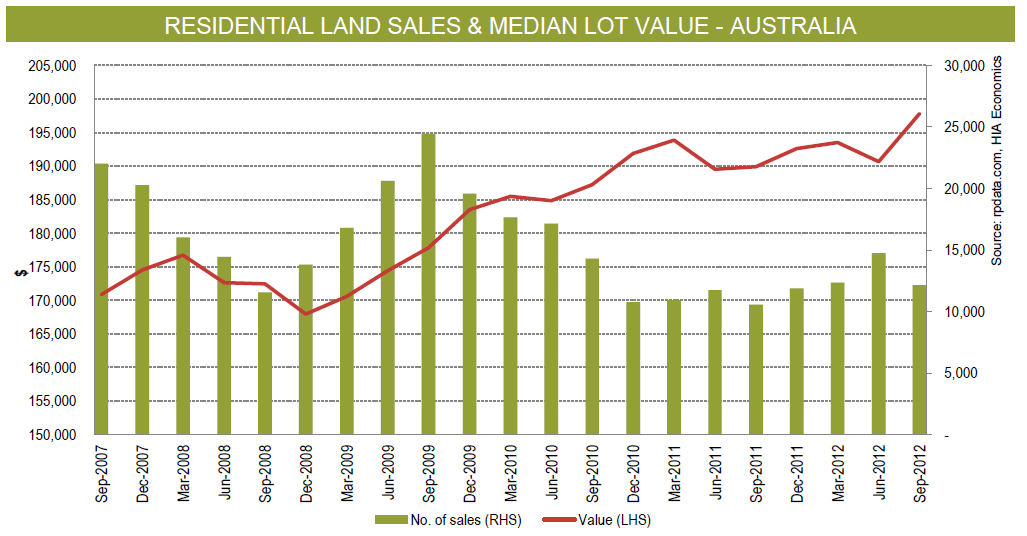
The Housing Industry Association (HIA) has just released its land sales report for the September quarter of 2012, which revealed a widening divergence between vacant land prices, which continue to climb higher, and the number of land sales, which dipped in the latest quarter and have barely moved since June 2011 (see next chart).

According to the HIA release:
The latest residential land update signals a long road ahead before new home building activity returns to healthy levels.
The HIA-RP Data Residential Land Report… highlights a significant decline in residential land sales in the September 2012 quarter.
“Residential land sales fell by 17.8 per cent in the September 2012 quarter, although the volume was still 14.9 per cent higher than the record low set a year earlier,” said HIA Chief Economist, Harley Dale.
“It is encouraging that land sales in a majority of markets have lifted off the depths plunged in 2011. However, this latest update highlights the uncertainty around whether the new home building sector can mount a recovery that is both sustainable and of the magnitude Australia’s population and economy require,” Harley Dale said.
“Overall, residential land sales, a key leading indicator of housing starts, signal a rocky road for any new home building recovery in 2013.”
“One catalyst for the emergence of a strong new home building recovery would be the reduction in the cost of new housing, including serviceable land, which is brought about by disproportionately high and inefficient levels of taxation,” added Harley Dale. “This requires bold and decisive policy reform across all levels of government, action which consistently fails to occur to the detriment of a more productive and efficient economy.”
According to RP Data’s research director Tim Lawless, the September results highlight the recovery in the vacant land market remains a fragile one. “After consistent increases in the number of vacant land sales over the past three quarters, the lower September result is a stark reminder that consumers remain very price sensitive and cautious about their household finances.”
“Land developers and builders are facing the challenge of providing affordable house and land packages at a time when land costs, as well as construction costs, continue to rise. The median price of a vacant block of land rose 3.8% over the September quarter last year despite the fall away in volume.”
“The broader housing market remains on a recovery trajectory, and I would be surprised if the vacant land market continued the slippage in transaction numbers we saw in September. Low interest rates and a subtle improvement in consumer confidence, together with Government incentives now more focussed on new housing, are likely to be the driver behind a gradually improving market.”
In the September 2012 quarter the weighted median residential land value in Australia increased by 3.8 per cent to $197,807. This value was 4.2 per cent higher when compared to the same period in 2011. The median value for capital cities increased by 5.1 per cent in the September 2012 quarter to $225,795, 6.0 per cent higher than in the September 2011 quarter. The median value for Regional Australia was $155,214 in the September 2012 quarter. This represents a quarterly rise of 0.8 per cent and a 0.2 per cent increase compared with the same period in 2011.
The divergence between land prices and sales is understandable given the extraordinary incentives being offered by Australia’s housing developers, such as offering buyers of new house and land packages free cars, landscaping, large cash-backs, or paying a buyer’s energy bills.
As explained previously (here and here), these types of back-door price reductions have been effective in maintaining the face value of land, but might also be precluding the new home market from functioning properly and could actually be stifling land sales:
A buyer of land that comes with an incentive, such as a new car, pays stamp duty on the higher contract price, resulting in more stamp duty being payable than if the price had been lowered by the amount of the incentive. Moreover, when the buyer seeks finance, the bank is more likely to value the property at a lower level than the contracted price, thereby reducing the amount that the bank will lend and effectively increasing the borrower’s required deposit.
Indeed, earlier this year it was reported that bank valuations on new house and land packages were coming in -15% below developers’ sale price valuations, meaning that new home buyers were being forced to contribute 15% more funds (on top of any housing deposit) in order to cover the valuation shortfall, or forfeit the sale.
However, while straight-out price reductions are superior to back-door reductions via incentives, Australia’s developers appear unable to cut prices directly:
Australia’s property development industry appears to be caught in a pincer. If they don’t abandon incentives in favour of transparent land price deductions, financing of new house and land packages will remain problematic and sales will likely continue to struggle. At the same time, reducing the listed price by the same value as the bonuses and incentives being offered could lower their collateral value, potentially triggering the banks to call in more equity from bank-financed developers to bring their loans back to agreed conditions and/or loan terms. Straight price cuts are also more likely to aggrieve recent purchasers that paid higher prices.
As noted previously, the core problem with the new house and land market in Australia is that prices remain above what many buyers can afford or are willing to pay. And until prices deflate, the rate of home sales and construction activity is unlikely to rebound materially, leaving Australia’s property developers holding large land banks that they cannot offload.
While I agree with the HIA that the level of tax levied on new developments and housing-related infrastructure is too high, and adds to the cost of new house and land packages, policy makers seeking to stimulate land sales and construction activity should also look at forcing greater competition and contestability on land-banking developers and land owners by removing artificial constraints on the quantity of land available for development (e.g. by removing restrictive zoning and urban growth boundaries). Policy makers should also consider reforming the tax system, namely implementing of a broad-based land tax in place of inefficient transaction taxes, in order to raise the holding costs of vacant land and increase the speed at which englobo land is brought to market.
HIA Land Sales Report (Sept Qtr 2012) by leithvanonselen

